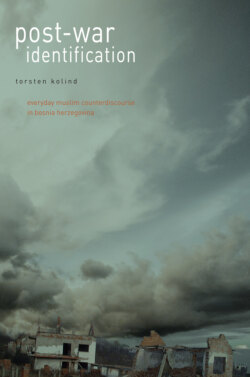Читать книгу Post-War Identification - Torsten Kolind - Страница 20
Experience
ОглавлениеElaine Scarry’s (1985) argument regarding the relation between torture and pain has served as an explicit or implicit theoretical inspiration in many of the ethnographic studies of people’s experiences of war and violence and loss of epistemological framework (Feldman et al. 1993; Green 1995; Jackson 2002; Maček 2000a, 2000b; Nordstrom 1997; Povrzanović 1993, 1997; Scheper-Huges 1992; Van de Port 1998). Her basic contention is that the feeling of physical pain is an irreducible bodily experience that cannot be objectified by anything outside the body including language. This is why torture is such an effective instrument of power, because the inexpressible and non-communicative feeling of pain, the ‘unmaking of the world’, as she calls it, that takes control of the victim can only be alleviated through a new version of the world − another version of the Truth (see also Löfving and Maček 2000: 5; Frykman 2002). Based on ethnographic fieldwork in war-torn Mozambique, Nordstrom (1997) expands Scarry’s idea of torture’s ‘unmaking of the world’ to the general wartime situation experienced by civilians. Nordstrom sees the structure of this experience as bearing clear parallels to Bakhtin’s idea of the grotesque:
When the familiar and everyday are turned into implements of torture and murder, the familiar everyday world is rendered grotesque – not merely by the fact of the present terror and repression, but by the enduring nature of association. (p. 168).
She offers an example of a man who had his throat cut in the family’s mortar by intruding soldiers, the whole village being forced to watch, and she asks if the onlookers will ever be able to use a mortar without having the drama run at the back of their minds. The strength of terror, she argues, exists in its ability to break down the everyday world and destroy the webs of significance into which people’s self-identities are woven. In this way terror was used intentionally by all parties in the war in Mozambique to eliminate political will and military resistance among civilians. But besides unmaking the world, terror also incites different kinds of resistance: retelling the grotesque practices and linking them with the perpetrators, rebuilding broken social relations and institutions of the community, and imagining a world beyond that could function as a source of creativity in everyday life. When listening to the horrible atrocities to which people had been subjected, Nordstrom was furthermore impressed by the concurrent life-generating creativity of her informants. In sum this made her see how in Mozambique peace and solid social relations were built from the bottom up. In a related but less optimistic study of the siege of Sarajevo, Ivana Maček (2000a, 2000b) invents the concept ‘the deserter’s mode of perception’ in an attempt to communicate people’s war experiences. The deserter’s mode is a process “… in which all individuals, faced with unexplainable violent disruptions of their lives, constantly engage in making sense of their situation” (Maček 2000a: 240). It is a sense-making process whereby people, in their attempt to categorise and understand the situation, easily fell victim to the nationalistic discourse that swept the country.
A problem with some of the ethnographies focusing on experiences of war and violence is that bare survival becomes labelled as resistance. This either romanticises people’s coping strategies or expands and thereby weakens the concept of resistance. However, it does focus on a crucial discussion: whether the creative component is violence (as the structural perspective has it) or people’s strategies and reactions toward violence. Does violence create identity, or is it people’s reactions to violence that create or destroy positions of identity?5 The focus on the disintegration of everyday life furthermore questions the concept of violence. Many scholars have asked: Is violence only physical? (See for instance Riches 1986; Nordstrom and Martin 1992; Nordstrom and Robben 1995; Simons 1999). I only want to add that violence does not need to physically attack the body to produce an ‘unmaking of the world.’ A constant threat of violence can disrupt the fabric of everyday life (see, for instance, Gilliland 1995; Ross 2001).
